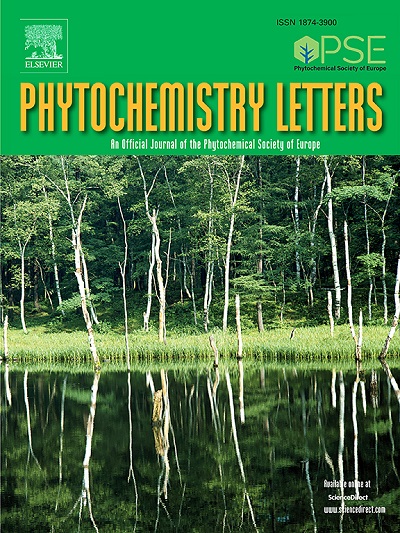新型l -香芹酮基噻唑腙衍生物的合成、抗真菌活性及3D-QSAR研究
IF 1.3
4区 生物学
Q4 CHEMISTRY, MEDICINAL
引用次数: 0
摘要
为了从天然产物中寻找新型高效杀菌剂,合成了24个l -香菜酮基噻唑腙衍生物5a-5x,并通过1H NMR、13C NMR、FT-IR和HRMS对其分子结构进行了确证。此外,对所有目标化合物进行了体外抑菌活性测定,结果表明,部分目标化合物对植物病原菌具有显著的抑制活性,特别是对番茄根霉和梨状Physalospora。例如,化合物5a (R = H)、5b (R = o- f)、5c (R = m-F)、5d (R = p-F)、5e (R = o,p-F)、5 f (R = m-Cl)、5j (R = m-NO2)、5q (R = o- och3)和5r (R = m-OCH3)对piricola Physalospora的抑菌活性优于百菌清(51.2 %)。此外,通过三维定量构效关系(3D-QSAR)研究了目标化合物的生物活性与其共同骨架上的取代基之间的关系。本文章由计算机程序翻译,如有差异,请以英文原文为准。
Synthesis, antifungal activity, and 3D-QSAR study of novel L-carvone-based thiazole-hydrazone derivatives
For exploring novel potent fungicides derived from natural products, 24 L-carvone-based thiazole-hydrazone derivatives 5a-5x were synthesized, and confirmed for their molecular structures by 1H NMR, 13C NMR, FT-IR, and HRMS. Besides, all the target compounds were bio-assayed to evaluate the in vitro antifungal activity and the results revealed that some of the target compounds showed significant inhibitory activity against the tested plant pathogens, especially for Rhizoeotnia solani and Physalospora piricola. For example, compounds 5a (R = H), 5b (R = o-F), 5c (R = m-F), 5d (R = p-F), 5e (R = o,p-F), 5 f (R = m-Cl), 5j (R = m-NO2), 5q (R = o-OCH3), and 5r (R = m-OCH3) exhibited better antifungal activity against Physalospora piricola than that of chlorothalonil (51.2 %). In addition, the three-dimensional quantitative structure-activity relationship (3D-QSAR) study was conducted to investigate the relationship between the bioactivities of the target compounds and the substituted groups bonding to their common skeletons.
求助全文
通过发布文献求助,成功后即可免费获取论文全文。
去求助
来源期刊

Phytochemistry Letters
生物-生化与分子生物学
CiteScore
3.00
自引率
11.80%
发文量
190
审稿时长
34 days
期刊介绍:
Phytochemistry Letters invites rapid communications on all aspects of natural product research including:
• Structural elucidation of natural products
• Analytical evaluation of herbal medicines
• Clinical efficacy, safety and pharmacovigilance of herbal medicines
• Natural product biosynthesis
• Natural product synthesis and chemical modification
• Natural product metabolism
• Chemical ecology
• Biotechnology
• Bioassay-guided isolation
• Pharmacognosy
• Pharmacology of natural products
• Metabolomics
• Ethnobotany and traditional usage
• Genetics of natural products
Manuscripts that detail the isolation of just one new compound are not substantial enough to be sent out of review and are out of scope. Furthermore, where pharmacology has been performed on one new compound to increase the amount of novel data, the pharmacology must be substantial and/or related to the medicinal use of the producing organism.
 求助内容:
求助内容: 应助结果提醒方式:
应助结果提醒方式:


